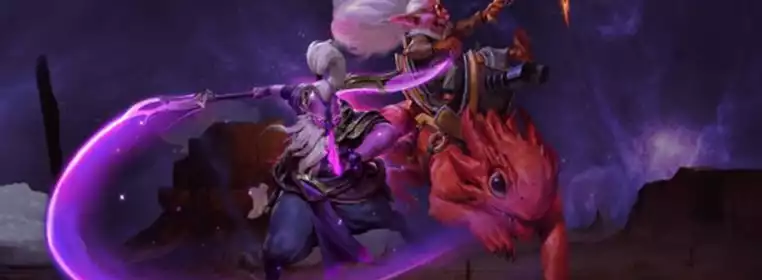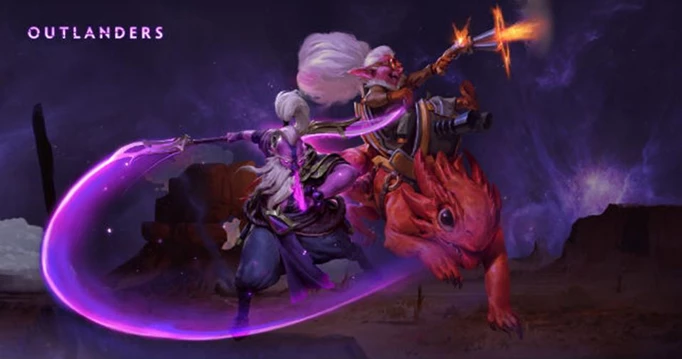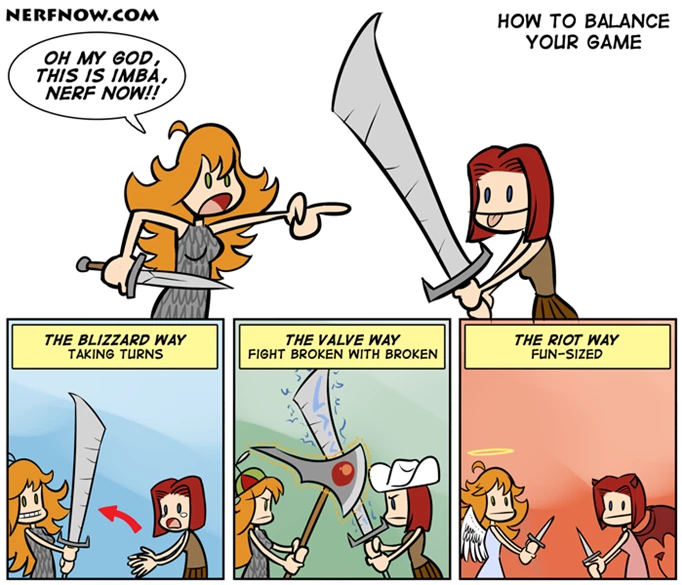No Update is Going to Destroy Dota 2, and Here’s Why

No, the [most recent] update won’t destroy Dota 2. The Outlanders update didn’t. The 7.00 talent tree update didn’t. Will Dota 2 lose some players? Probably, and several pieces of evidence have proven so. Will the game magically die? No way.
To explain why, let’s take a little journey all the way back to the humble Starcraft custom map, Aeon of Strife. AoS is the grandfather of MOBA/ARTS. Did Gunner_4_ever, the creator, know that his creation would eventually spawn two of the biggest esports titles in the world, with thousands of viewers cheering in stadiums and millions more enraptured behind the screen? Nope. But they did it anyway. Gunner_4_ever loved the idea of controlling a single, powerful unit, focusing on the overall macro game rather than the intense micromanagement Starcraft required.
AoS went onto inspire Defense of the Ancients, a custom map in Warcraft 3. It spawned endless variants, with each creator trying to add their own special twist to the map in order to make theirs the premier version. Two modders, Meian and Ragn0r, made the decision to bring the best heroes from each version into one, and christened it DotA Allstars.
DotA Allstars
It made sense that the one version that combined everything took off, didn’t it? Dota, at its core, is a hodgepodge of different game mechanics. The RPG aspect of controlling one unit, levelling it and equipping items to make one stronger. The barebones strategy aspect of players wrestling for control over specific areas of the map. The action aspect of combat and striving for victory through pure mechanical skill. It was like nothing that existed. And it was a hit.
Needless to say, the rest is history. There’s been dozens of developers and modders throughout the years, with varying degrees of success. Some left for greener pastures, but for DotA and Dota 2, IceFrog’s name reigns supreme.
IceFrog
Little is known about IceFrog. He took over the DotA AllStars mod in 2005 and has been the lead developer ever since. He was the person that moulded a Frozen Throne mod into one of the most popular maps on Battle.net. Blizzard even hosted a DotA competition at Blizzcon 2005.
For 14 years, IceFrog has slaved away for millions of fans. He has a (probably) cushy job at Valve now, but he was an iconic figure long before he was being paid for developing DotA. IceFrog almost single-handedly brought DotA to the forefront of the gaming world and has kept Dota 2 similarly in check.
Dota 2 is renowned for its exceptional balance between heroes. Dota 2’s most recent premier event, The International 2019, only had three heroes unpicked through the tournament. It’s also known for some hilariously broken stuff, with hero concepts, abilities, and stats all turned up to 11.

 Click to enlarge
Click to enlarge
 Click to enlarge
Click to enlarge
The Success of Flawed Heroes
If you aren’t familiar with Dota 2, the first look at any hero will likely make your jaw drop. A hero that can just disable a person’s entire skillset and inventory for 16 seconds? A hero that can instantly reset his cooldowns? A hero that can literally stop time in a huge AoE? The list goes on and on, and somehow, someway, IceFrog has found a way to keep them all in balance by mostly following one rule: each hero has to be very good at something, and missing a critical element in their kit.
Most Dota 2 heroes are not generalists. Even heroes that started with the exact same spells have been tweaked to differentiate their identities. A hero like Tinker sounds overpowered in theory, but he’s plagued by poor mobility and high mana costs. Enchantress pumps out pure damage and is hard to kill with physical damage, but melts to any magic damage source. So, most heroes have massive drawbacks built either into the hero or item roster. A key portion of how good a player is revolves around them adapting their line-up and item decisions according to their opponents.
Sure, there’s been gross missteps along the way. There have been several patches where certain heroes were gross and overpowered. The surprising thing is that, a lot of those times, it wasn’t because heroes or items were over-buffed. Rather, Dota 2 is a game with so many different layers that minor changes cause big ripples in the meta.
Let’s take the infamous 6.83 patch, for example. The patch became notorious as “Ho Ho Ha Ha” patch, due to Sniper’s voiceline. Initially, people thought Sniper got weaker. His Shrapnel ability gained three charges, but lost the ability to damage structures.
Illusion and Farming
Like most esports, strategies bleed from the very top. Illusions were nerfed, so pros started relying less on illusion heroes and Manta Style, because they were naturally weaker. But they wanted a farming item, so they still went Yasha, upgrading it into Sange & Yasha instead.
Then, they realised that the stat-based items carries were going for, meant that they could be greedier. Mask of Madness became the trending first item for carries to pick up, before Yasha, as it gave movement speed and attack speed, two essential tools for farming quickly.
Since Mask of Madness reduced armour, carries picked up stat-based items to counteract the side-effect. The most stat-dense item in the game for agility heroes, other than Sange and Yasha, was Eye of Skadi. Suddenly, every agility carry in the game went for these three items, whether it was Sniper, Troll Warlord, or Juggernaut.
It wasn’t a simple buff or nerf. It’s not a single string, where pulling at one end inevitably moves the the other. Dota 2 was a complex web, where tugging at one corner affects every other thread. IceFrog understands that concept intimately.
Mad Science
In a sense, removing things from Dota 2 will make the game easier to balance. If nothing else existed but two different heroes whacking each other in the face, perfect balance would be achieved by tweaking it until both units die at the exact same time. It’s just like how science experiments change just one variable for accurate results. But, if IceFrog is a scientist, he’s clearly a mad one. He did the exact opposite.
IceFrog just kept adding stuff. He implemented Bounty Runes in 6.82, Scan in 6.87, talents and backpacks in 7.00, and neutral items plus a brand-new objective, Outposts, in 7.23. Why? Because the more complex the web is, the less a single tug will cause ramifications for the rest of the threads.
Dota 2 isn’t a science experiment. It’s a madcap romp through Wonderland, filled with characters as varied and colourful as the ones in Arkham Asylum. Introducing more ways to play the game allowed for more varied strategies. Bounty Runes began as a consolation prize to even out mid-lane rune battles but evolved into a prime objective for players to battle around. Scan rewarded players both offensively and defensively, with solid map reads, even without wards. Talents allowed IceFrog to balance a hero in yet another way, providing power spikes accordingly. Backpack slots allowed for smoother item transitions and allowed for more late-game shenanigans.
IceFrog’s Plan
Undoubtedly, IceFrog has a plan for neutral items and outposts. Maybe it’s to reward players even further for controlling the map well, forcing the losing team to abuse map movement in order to even out the advantage. Maybe it’s to break stalemates by introducing powerful items that work best on different heroes and roles. Whatever the case is, it’s unlikely for IceFrog and co. not to have a plan.
Of course, that’s not to say that IceFrog hasn’t made mistakes. After all, he’s just a frozen amphibian. Yet, he’s always been receptive to community feedback. IceFrog used to contact pro players to ask for their opinions. Now, he’s got a team at Valve behind him, but the same principles apply.
Respawn talents were deleted from the game. Cinder Brew’s forced elemental interaction was removed. Most recently, neutral items Tome of Aghanim and Third Eye didn’t even last a month. If something doesn’t work, voice it out!
Final Word
It’s completely OK to criticise and complain about the game. Most of the times, these grumbles come from a place of worry and genuine love for Dota 2. We wouldn’t say a word if we didn’t care about all the changes its going through. We are like worrywart uncles and aunts to a wild teenager, we can try and help as much as we can. In the end, the power to help and guide this teenager into a capable adult is its parents, IceFrog and Valve.
The problem occurs when we proclaim a new update as the death of Dota 2. Will it die eventually? In all honesty, yes. Video games, and especially esports, has had a short life in humanity’s zeitgeist. Will esports even exist 10 years in the future? Its trending upwards for now, but we never know when it will all come crashing down. Will Dota 2 go down in history as the video game equivalent of Lord of the Rings or a recent New York Times bestseller? We simply cannot know.
Dota 2 has changed. Dota 2 will continue to change. It might not look, play, or feel like what you know. But it’s still about defending the Ancient. It’s still the never-ending battle between Radiant and Dire. There’s no shame in feeling overwhelmed by it. Quit the game if you have to, and comeback when you want to. It could be for our hilarious memes, or to watch professionals play the game in a way you can never imagine. Sometimes, it can even be both.
There’s a reason why, despite Dota 2’s declining player base, TI9 was the most watched Dota 2 event of all time.
One day, the last match of Dota 2 and all its subsequent sequels will be played. We might not be alive then, but those 10 players will be. They will crack open their preferred beverage, raise it in respect, and reminisce about the good old days when they had to download separate replay and audio files to watch professionals fight. Or maybe they will recall when they had to use a keyboard and mouse instead of a mind computer.
For now, enjoy your talent trees, bounty runes, and neutral items, and savour the sights and sounds of the crazy Dota 2 world. It’s not perfect, but it’s ours.
